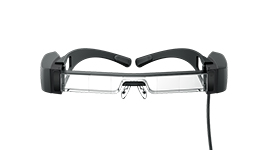Engineer Interviews
Moverio and the Future of Visual Innovation
While most of the head-mounted displays (HMDs) sold by manufacturers in Japan and abroad are designed to close out the world, Epson adopted a different approach and took on the far more daunting challenge of developing a see-through HMD. We talked with the system engineer who was responsible for Epson's Moverio smart glasses to learn why the development team took the approach they did and to find out the vision for the future.

VSM Project Fujimaki
Position Sensing
Challenging the Unknown for a Freer Visual Experience
How did the Moverio project get started?
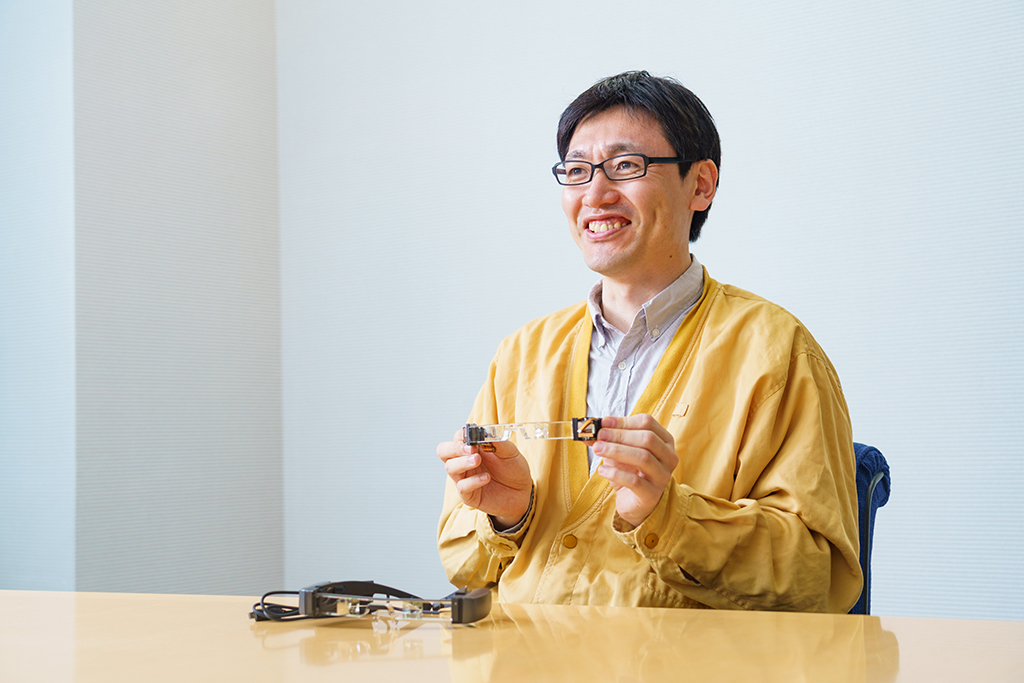
FujimakiIn the fall of 2009, when I was involved in the development of organic EL displays, the people in the R&D department used to regularly meet with then-president Minoru Usui to discuss whether we could use our existing core technologies to create products in new areas. We already had microdisplay and optical projection technologies that We thought could be used to createproducts in new fields. Eventually, head-mounted displays emerged as a strong candidate for the application of these technologies.
We dug deeper into head-mounted displays and got the go-ahead from the president, who was very receptive to the idea of commercialization, so that really kicked off the project. Product development started with a team of nine people who had backgrounds in different technological fields. Our goal was to use existing assets of the projector business to develop a new type of head-mounted display that would allow users to enjoy perceived big-screen entertainment anytime, anywhere, and in any position they wanted. Although we already belonged to an existing department, the project team reported directly to the president. In retrospect, I'm amazed that we started working toward commercialization with such a small team. After about two years, and with the help of various other departments, we had a product on the market in time for the 2011 Christmas season. That was the BT-100, the world's first stand-alone see-through smart glasses.*
- *Released on November 25, 2011, the BT-100 was the world's first pair of binocular consumer smart glasses to offer audio-visual content wirelessly. (Source: Epson research)
At the time, there weren't really any products on the market that you could use for reference. You were making a new category of product, so what was your perception of the market?

FujimakiAround the time that we were looking into commercializing the BT-100, video sharing services began gaining traction with the general public and the number of people who owned a smartphone was gradually rising. That was when we started to see the emergence of a cultural phenomenon that we now take for granted: people spending a portion of their free time watching videos on mobile devices. Domestic 4G service was being rolled out, and we thought that opportunities to watch video content would expand further in the future.
Given the changes that were unfolding, and guided by the goal of enabling people to enjoy perceived big-screen entertainment anytime, anywhere, and in any position they want, we defined the essential features of our product. We wanted it to be binocular and see-through so that users could simultaneously see projected images and their surroundings. We wanted it to be as easy to put on and take off as a pair of glasses. We also wanted it to operate as a stand-alone with a built-in battery so that users would be able to enjoy video content on the move.
We have categorized the Moverio series as smart glasses or as smart headsets because in addition to acting as a simple monitor like conventional head-mounted displays, they have wireless communication capability and various sensors that enable other features.
The Moverio series can play content from an SD card. These smart glasses also support mirroring over Wi-Fi and are DLNA-certified, so you can share video from a Blu-ray player via Wi-Fi. They allow you to take your videos anywhere with you. On the other hand, the Moverio lineup also provides simple means for connecting to personal computers and AV equipment. Models may come with HDMI, USB-C, and other interfaces for wired connections so that you can easily connect to existing host devices.
We found out after the BT-100 hit the market that the need for these types of devices is much greater than we had expected. There are entertainment applications and tourism applications that use augmented reality. You can also use a head-mounted display to provide remote support to people in overseas factories without jumping on a plane. Work that takes place at elevated heights, such as on utility poles and steel towers, used to require two people. Now, however, a head-mounted display can be used to give instructions from a remote location, such as an office, so the number of people in the field can be reduced and work can be performed more efficiently. There is still room for improvement, but we will need to know exactly where and how customers will use our products.
Pioneering Development Required
If see-through head-mounted displays are technically more difficult to engineer than closed-type headsets, why did you choose to take the more difficult route?
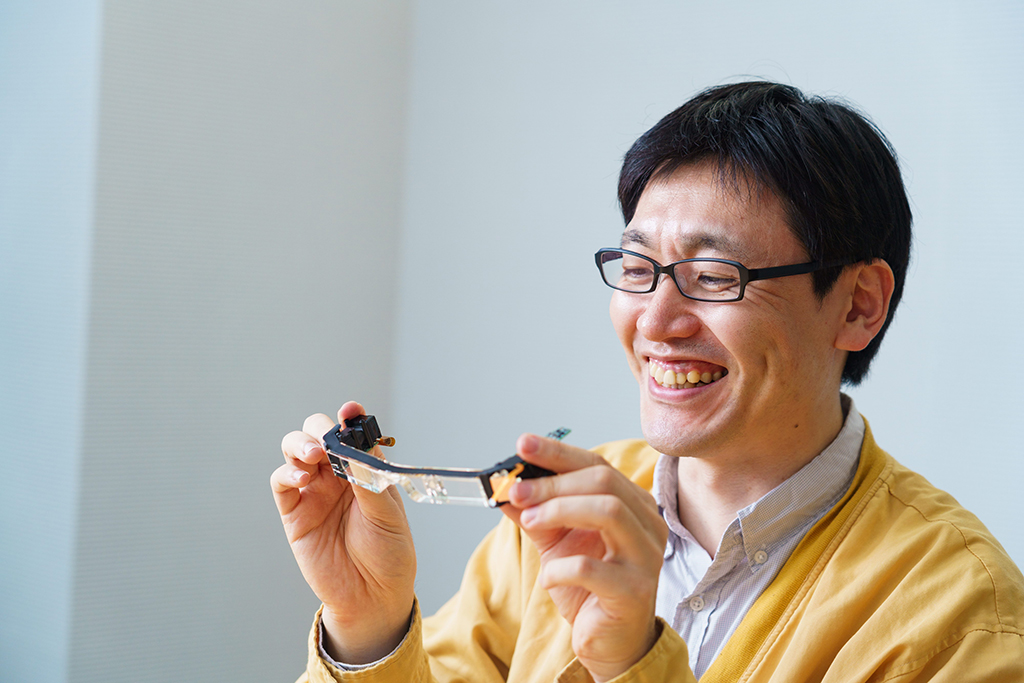
FujimakiWhen we were getting started, competitors were announcing their own new head-mounted displays that had optics that were not see-through, but there was a lot of debate about what would be the ideal form factor. Would it be see-through or not see-through? If it were see-through, would it be monocular to minimize the size and weight, or would it be binocular for stereoscopic vision?
We thought that we would end up with a wearable display that would allow you to enjoy images outdoors and on the move. So, although we knew that there would be technical hurdles to overcome and that development would take time, we decided on a see-through, binocular headset.
Headsets generally fall into one of two categories, see-through and not see-through. While the not see-through type is becoming more widely used by general consumers for things like VR games, the see-through type seems to be more focused on commercial applications. The value of see-through headsets for users is becoming clearer. They can, for example, provide remote assistance or work hands-free. Meanwhile, we are providing applications and supporting usability in remote work.
What were some of the difficulties you faced during development?
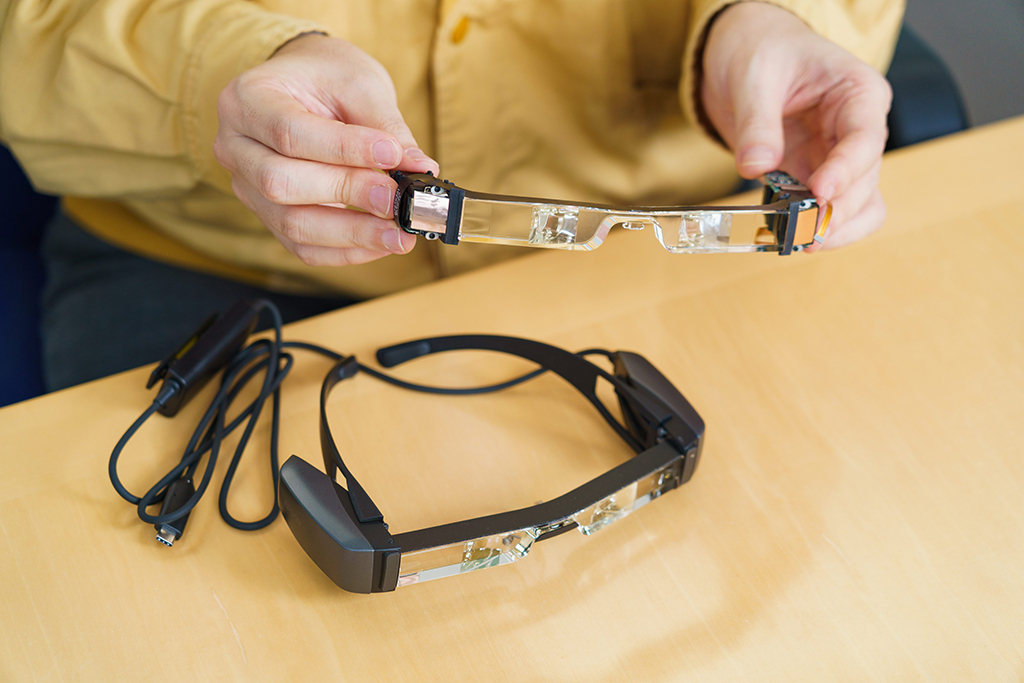
FujimakiSince we chose to try to create a binocular, see-through system for the Moverio, we faced a constant struggle, from the development of the optical engine all the way through to volume production.
Achieving both a quality image on the display and good see-through performance was a real challenge because it requires complex optical engineering and verification capabilities, as well as precision production technology. We ran into all kinds of problems. Even the slightest deviation from the engineered design or the misalignment of bonded pieces in manufacturing can cause ghost images to appear outside the display frame or can distort real world scenery. And when we made an actual prototype, we found that verification was impossible with conventional optical simulations.
We are very particular about how the images look on our unique microdisplays, so the design engineering and manufacturing teams worked together to analyze and solve the causes of the problems before moving to volume production.
It was also difficult to achieve an overall balance as a product, because while we have to improve display performance and add features, but we also have to consider wearability and appearance. I think that will be an ongoing issue for head-mounted displays. If you widen the angle of view to achieve more compelling images, you have to make the optical engine that much larger, which increases the weight of the headset.
We also struggled with the design. Ideally, the headset should be small, but people's heads come in all shapes and sizes. Moreover, the headset has to be equally comfortable for those who wear glasses and those who don't. The optimum mounting position for the customer varies greatly due to various factors. We collected data on things such as head size, the positional relationship between ears and nose, and interpupillary distance, and we came up with a lot of different design ideas and produced a bunch of mockups that we had people actually try on to see what would be most comfortable for the largest number of people.
Since I was responsible for system design, I had to find ways to address issues with heating and noise, which became problems as features were added and the products got smaller. As the speed of video signals increased along with picture resolution and as the headsets got smarter with the addition of features such as cameras and motion sensors, I was faced with the problem of minimizing heat and EMC noise while also finding a way to keep the design compact. Ultimately, we came up with a small, multi-functional headset that meets wearable device quality and safety requirements by developing a dedicated hybrid harness to resolve the noise problem and by using our own thermal simulation technology based on past product development experience to optimize heat dissipation.
What new technologies came out of Moverio development?
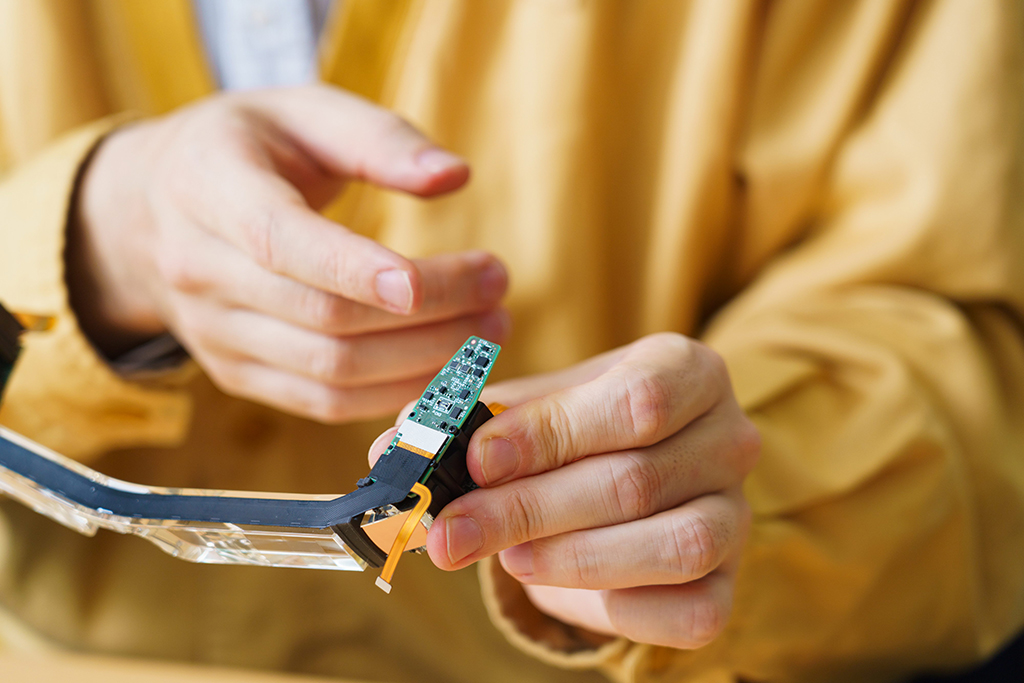
FujimakiThe microdisplays used in the Moverio series are based on technology developed for projectors, but the structure of those used in projectors and those used in smart glasses is different. Projectors have three displays, one each for red, green, and blue. The images from these displays are superimposed on one another to create the final, full-color image. In contrast, the panels used in the Moverio have an RGB color filter, so each panel produces a full-color image. The single-panel design was used for the Moverio because whereas projectors require high-brightness, head-mounted displays need to be small. Epson's unique single-panel full color microdisplays are the core technology that determines the quality of Moverio images.
We started using newly developed Si-OLED technology beginning with the third generation of optical engines. Si-OLED display panels provide better performance, with higher contrast and a wider color gamut. The Si-OLED displays in the fourth generation of optical engines measure 0.45 inches and offer 1920 x 1080 resolution. To give you an idea of the level of definition that these panels provide in terms of pixel density, a typical smartphone has a pixel density of about 600 pixels per inch. These panels have more than 4800 pixels per inch.
Furthermore, when we switched to using Si-OLED panels, we adopted a unique light distribution control technology that was difficult to use for such general purpose panels. By co-designing this with the optical unit, we also succeeded in reducing the size of the headset.
The adoption of these technologies has enabled us to design a product that is lightweight yet has a wide field of view (FOV). The original Moverio, the BT-100, weighed 240 grams and had an FOV of 23 degrees, which is equivalent to looking at an 80-inch screen from five meters away. In contrast, the latest generation of Moverio, the BT-40, weighs 95 grams and has an FOV of 34 degrees, which is equivalent to looking at a 120-inch screen from 5 meters away.
An Age of Ubiquitous Wearable Displays
How will smart glasses evolve from here?
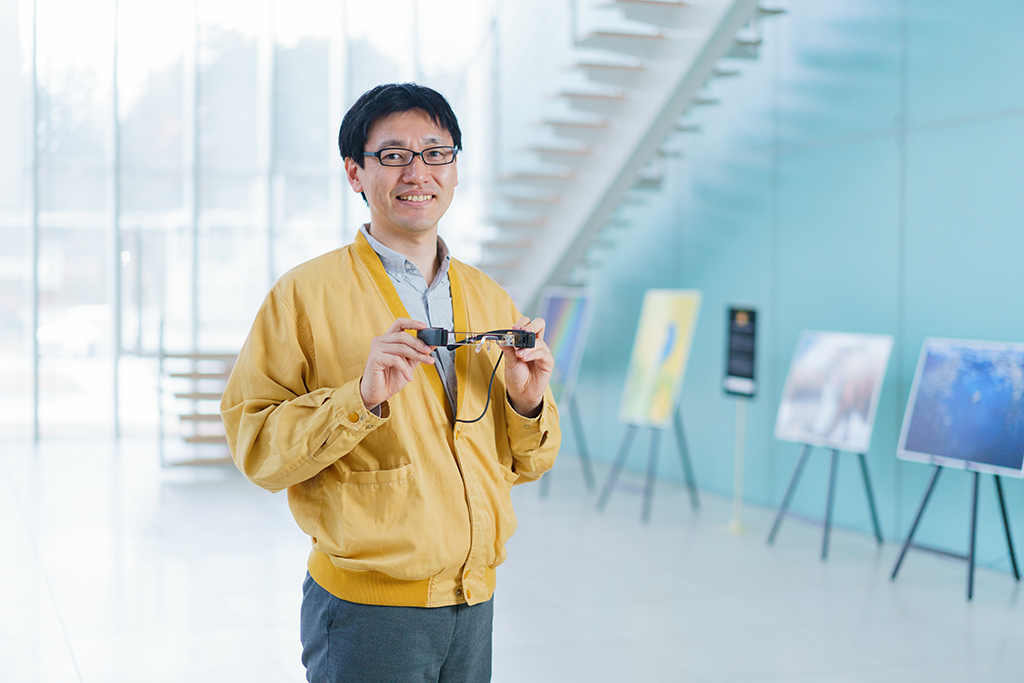
FujimakiSee-through smart glasses are presently geared more toward the enterprise market than for everyday use by ordinary consumers, and we are seeing the number of business applications for see-through smart glasses grow because they free up your hands and allow you to simultaneously view displayed images and your surroundings. Or, because they are equipped with a camera, they allow you to share visual information with a remote location and thus provide remote assistance to people in the field.
Headsets equipped with sensors are increasingly being used to display 360-degree videos and AR content on guided tours for visitors at tourist spots such as amusement parks, art galleries, and museums. Our smart glasses have been adopted for real-life applications overseas, where they are used to display subtitles for the hearing impaired and subtitles with simultaneous interpretation for opera-goers.
What I personally have the highest hope for is a hybrid between traditional sports and e-sports, with both real world and augmented reality elements. At a baseball game held at the Sapporo Dome, in Japan, we conducted a trial that proved to be very popular. A group of people from overseas were given a Moverio headset to wear while taking in the game so that they could see scores, listen to commentary, and have access to other information on-screen. If this idea develops further, a new type of sports entertainment in which space is recognized in real-time and AR effects are overlaid on the surroundings should become possible.
Our goal is to expand and enhance headset use cases and content to create an age of ubiquitous wearable displays in which it is as normal to wear a pair of smart glasses as it is to carry a smartphone today. The Moverio series is second to none in terms of basic image display performance parameters such as brightness, image quality, and binocular vision. On the other hand, there simply is not enough content for smart glasses on the market, so rather than rely solely on our own technology, we will actively collaborate with partners to create markets through open innovation.
The Moverio brand logo signifies our commitment to creating a new visual culture of mobile big screens. I want to capitalize on Epson's strengths to bring about a world in which wearable displays are the norm.
The titles and positions are as of the time of interviews in November 2020.



